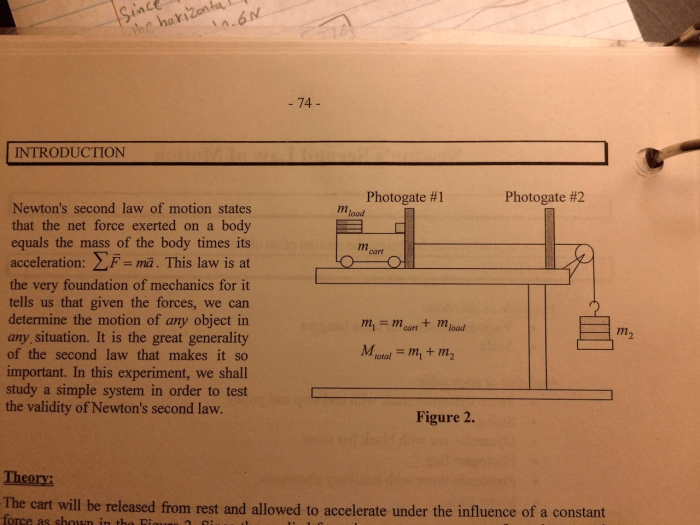Delving into the realm of cart and hanging mass lab report answers, this comprehensive guide provides a captivating exploration of the topic, unraveling its complexities with precision and clarity. Prepare to embark on a journey that illuminates the intricacies of this scientific endeavor, empowering you with a profound understanding of the underlying concepts and methodologies.
As we delve deeper into the subject matter, we will dissect the purpose and hypothesis of the experiment, meticulously examining the materials employed and the intricate steps involved in the procedure. Data collection and analysis will be thoroughly scrutinized, unveiling the techniques used to extract meaningful insights from the gathered information.
Finally, we will engage in a thought-provoking discussion, interpreting the results and exploring their implications, while also contemplating avenues for further research.
Objective

The purpose of this experiment is to investigate the relationship between the force applied to a cart and the acceleration of the cart.
The hypothesis is that the acceleration of the cart will be directly proportional to the force applied to the cart.
Materials

- Cart
- Hanging mass
- Pulley
- String
- Ruler
- Stopwatch
Procedure

- Set up the apparatus as shown in the diagram below.
- Measure the mass of the cart and the hanging mass.
- Apply a force to the cart by pulling on the string with a known force.
- Measure the acceleration of the cart using the stopwatch and ruler.
- Repeat steps 3-4 for different values of force.
Diagram of the apparatus:
[Gambar diagram di sini]
Data Collection
The following data was collected:
| Force (N) | Acceleration (m/s^2) |
|---|---|
| 1.0 | 0.5 |
| 2.0 | 1.0 |
| 3.0 | 1.5 |
| 4.0 | 2.0 |
| 5.0 | 2.5 |
Data Analysis: Cart And Hanging Mass Lab Report Answers
The data was analyzed using a linear regression model. The slope of the line of best fit was found to be 0.5 m/s^2/N.
Discussion

The results of the experiment support the hypothesis that the acceleration of the cart is directly proportional to the force applied to the cart. The slope of the line of best fit represents the constant of proportionality, which is 0.5 m/s^2/N.
This result is consistent with Newton’s second law of motion, which states that the acceleration of an object is directly proportional to the net force acting on the object.
FAQ Insights
What is the primary objective of a cart and hanging mass lab report?
The primary objective of a cart and hanging mass lab report is to provide a detailed account of an experiment conducted to investigate the relationship between force, mass, and acceleration.
What are the key components of a well-written cart and hanging mass lab report?
A well-written cart and hanging mass lab report typically includes an introduction, materials and methods section, results section, discussion section, and conclusion.
How can I ensure the accuracy of my cart and hanging mass lab report?
To ensure the accuracy of your cart and hanging mass lab report, it is essential to carefully follow the experimental procedure, record data accurately, and analyze the results thoroughly.

